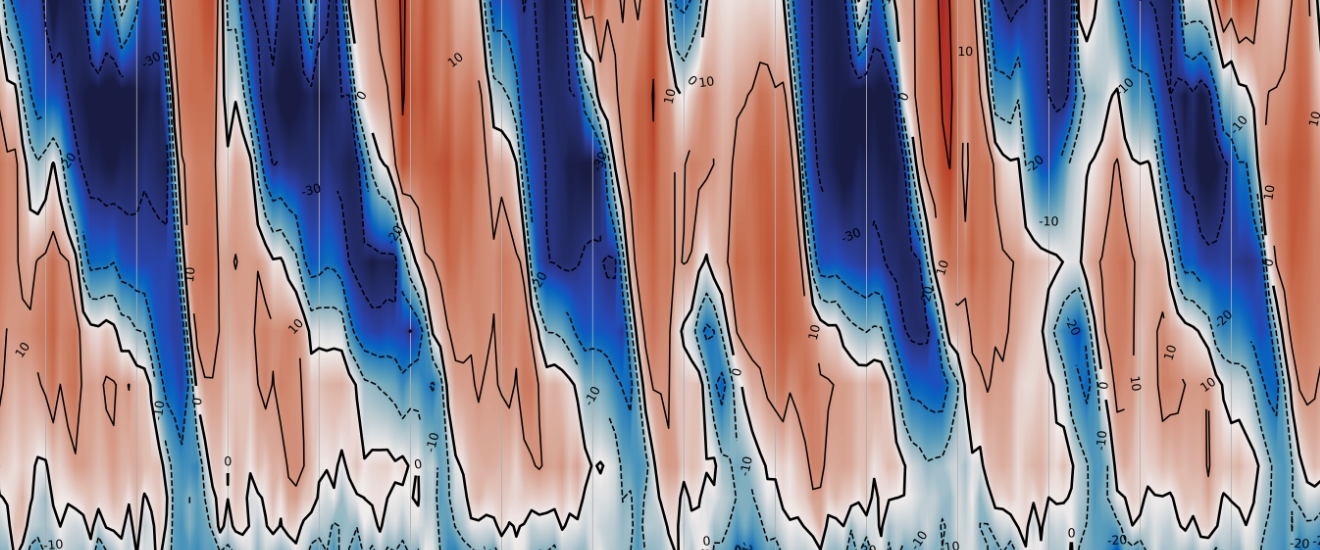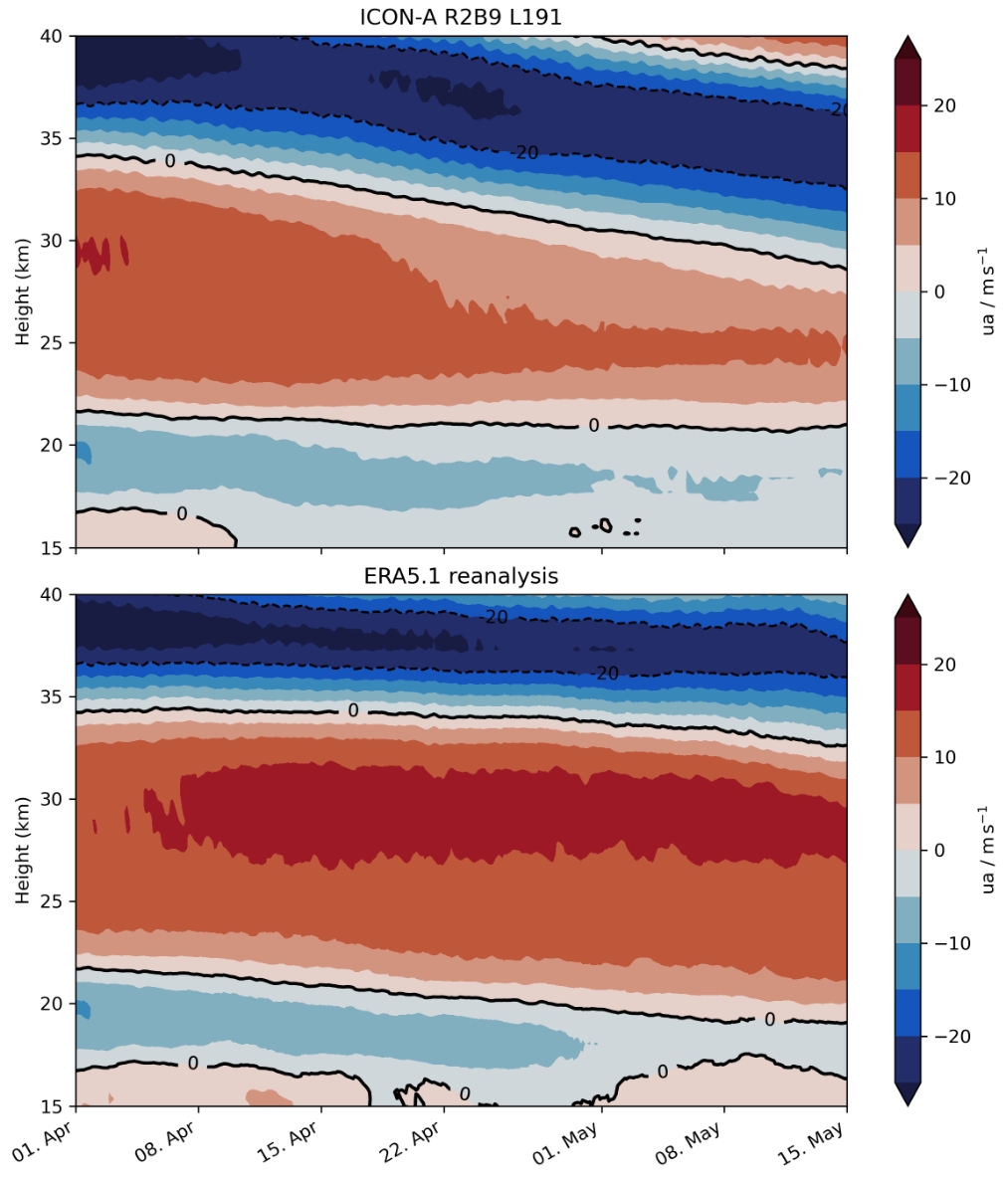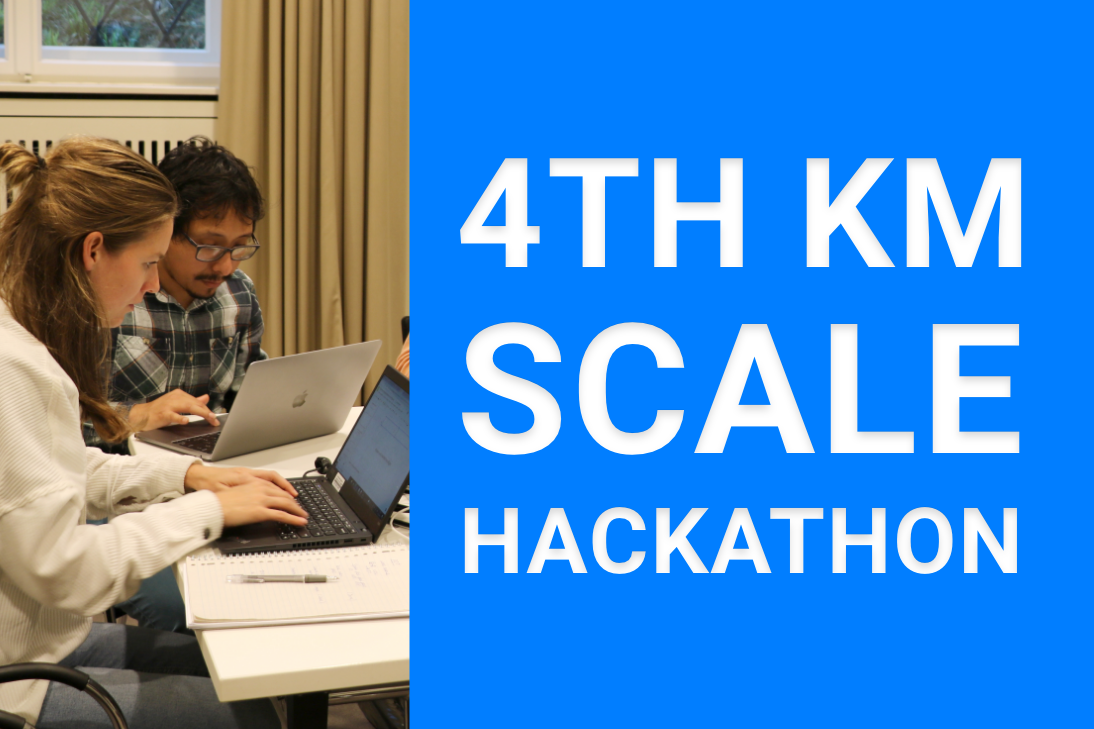
Wellengetriebene Zirkulation
Wenn großräumige Windsysteme durch die Wirkung kleinerer Wellen verändert werden, und sich dadurch auch die Wellen verändern, sprechen wir von einer Wechselwirkung zwischen Wellen und der mittleren Strömung. Ein bekanntes Beispiel und auch Gegenstand unserer Forschung ist die quasi-zweijährliche Oszillation (QBO).
Die QBO besteht aus westlichen und östlichen Windbändern, sogenannten Jets, die hoch über dem Äquator rund um den Globus verlaufen. Jeder Jet entsteht in der höheren Stratosphäre, von wo aus er sich nach unten bis in die Nähe der Tropopause bewegt. Hat sich ein Westwindjet genügend weit nach unten bewegt, entsteht darüber ein Ostwindjet, und umgekehrt. Ein vollständiger Zyklus hat eine Länge von etwas mehr als 2 Jahren. Die Ausbreitung dieser Jets nach unten und das Vorhandensein von Westwindjets am Äquator sind das Ergebnis der Wechselwirkung zwischen Wellen und der mittleren Strömung.
An diesem Mechanismus sind viele Skalen beteiligt, von Schwerewellen mit Längenskalen von ca. 100 km bis zur globalen Skala der QBO-Jets. Die Interaktion solch unterschiedlicher Skalen macht die QBO zu einem besonders interessanten Fall dieser Wechselwirkung zwischen Wellen und der mittleren Strömung. Diese Wechselwirkung macht auch den Versuch die QBO zu modellieren zu einer großen Herausforderung.
Mit unserer Forschung möchten wir die Details dieser Wechselwirkung besser verstehen und darüber hinaus herausfinden, wie die Prozesse, die die QBO erzeugen, und die QBO selbst von den Klimabedingungen abhängen. Daher ist unsere Gruppe bestrebt, ein innovatives numerisches Modell zu entwickeln um die erste direkte Simulation der QBO durchzuführen, bei der die Dynamik von der hochreichenden Konvektion über die tropischen Wellen bis zur QBO aufgelöst wird. Solche Simulationen werden uns neue Einblicke in die Kopplung zwischen diesen Phänomenen und deren Empfindlichkeit gegenüber Klimaänderungen geben.

Gruppenmitglieder und Publikationen
- Bonnet, P., Pastori, L., Schwabe, M., Giorgetta, M., Iglesias-Suarez, F. & Eyring, V. (2025). Tuning the ICON-A 2.6.4 climate model with machine-learning-based emulators and history matching. Geoscientific Model Development, 18(12), 3681-3706. doi:10.5194/gmd-18-3681-2025 [publisher-version]
- Morioka, Y., Maisonnave, E., Masson, S., Rousset, C., Kornblueh, L., Giorgetta, M., Nonaka, M. & Behera, S. (2025). Global ocean and sea ice variability simulated in eddy-permitting climate models. EGUsphere, . doi:10.5194/egusphere-2025-2258 [Preprint] [pre-print]
- Naumann, A., Esch, M. & Stevens, B. (2025). How the representation of microphysical processes affects tropical condensate in the global storm-resolving model ICON. Atmospheric Chemistry and Physics, 25(12), 6429-6444. doi:10.5194/acp-25-6429-2025 [publisher-version]
- Bonnet, P., Pastori, L., Schwabe, M., Giorgetta, M. & Iglesias-Suarez, F. (2024). Tuning a climate model with machine-learning based emulators and history matching (under open review). doi:10.5194/egusphere-2024-2508 [Preprint] [pre-print]
- Franke, H. (2024). The quasi-biennial oscillation in a warming climate. Phd Thesis, Berichte zur Erdsystemforschung, 278. [publisher-version]
- Franke, H. & Giorgetta, M. (2024). Toward the direct simulation of the quasi-biennial oscillation in a global storm-resolving model. Journal of Advances in Modeling Earth Systems, 16: e2024MS004381. doi:10.1029/2024MS004381 [publisher-version][supplementary-material]
- Heuer, H., Schwabe, M., Gentine, P., Giorgetta, M. & Eyring, V. (2024). Interpretable multiscale machine learning-based parameterizations of convection for ICON. Journal of Advances in Modeling Earth Systems, 16: e2024MS004398. doi:10.1029/2024MS004398 [publisher-version]
- Willson, J., Reed, K., Jablonowski, C., Kent, J., Lauritzen, P., Nair, R., Taylor, M., Ullrich, P., Zarzycki, C., Hall, D., Dazlich, D., Heikes, R., Konor, C., Randall, D., Dubos, T., Meurdesoif, Y., Chen, X., Harris, L., Kühnlein, C., Lee, V., Qaddouri, A., Girard, C., Giorgetta, M., Reinert, D., Miura, H., Ohno, T. & Yoshida, R. (2024). DCMIP2016: The tropical cyclone test case. Geoscientific Model Development, 17, 2493 – 2507. doi:10.5194/gmd-17-2493-2024 [publisher-version]
- Franke, H., Preusse, P. & Giorgetta, M. (2023). Changes of tropical gravity waves and the quasi-biennial oscillation in storm-resolving simulations of idealized global warming. Quarterly Journal of the Royal Meteorological Society, 149, 2838-2860. doi:10.1002/qj.4534 [publisher-version]
- Hohenegger, C., Korn, P., Linardakis, L., Redler, R., Schnur, R., Adamidis, P., Bao, J., Bastin, S., Behravesh, M., Bergemann, M., Biercamp, J., Bockelmann, H., Brokopf, R., Brüggemann, N., Casaroli, L., Chegini, F., Datseris, G., Esch, M., George, G., Giorgetta, M., Gutjahr, O., Haak, H., Hanke, M., Ilyina, T., Jahns, T., Jungclaus, J., Kern, M., Klocke, D., Kluft, L., Kölling, T., Kornblueh, L., Kosukhin, S., Kroll, C., Lee, J., Mauritsen, T., Mehlmann, C., Mieslinger, T., Naumann, A., Paccini, L., Peinado, A., Praturi, D., Putrasahan, D., Rast, S., Riddick, T., Roeber, N., Schmidt, H., Schulzweida, U., Schütte, F., Segura, H., Shevchenko, R., Singh, V., Specht, M., Stephan, C., von Storch, J., Vogel, R., Wengel, C., Winkler, M., Ziemen, F., Marotzke, J. & Stevens, B. (2023). ICON-Sapphire: simulating the components of the Earth System and their interactions at kilometer and subkilometer scales. Geoscientific Model Development, 16, 779-811. doi:10.5194/gmd-16-779-2023 [publisher-version]
- Quaglia, I., Timmreck, C., Niemeier, U., Visioni, D., Pitari, G., Brodowsky, C., Brühl, C., Dhomse, S., Franke, H., Laakso, A., Mann, G., Rozanov, E. & Sukhodolov, T. (2023). Interactive stratospheric aerosol models' response to different amounts and altitudes of SO2 injection during the 1991 Pinatubo eruption. Atmospheric Chemistry and Physics, 23, 921-948. doi:10.5194/acp-23-921-2023 [publisher-version][supplementary-material]
- Giorgetta, M., Sawyer, W., Lapillonne, X., Adamidis, P., Alexeev, D., Clement, V., Dietlicher, R., Engels, J., Esch, M., Franke, H., Frauen, C., Hannah, W., Hillman, B., Kornblueh, L., Marti, P., Norman, M., Pincus, R., Rast, S., Reinert, D., Schnur, R., Schulzweida, U. & Stevens, B. (2022). The ICON-A model for direct QBO simulations on GPUs (version icon-cscs:baf28a514). Geoscientific Model Development, 15, 6985-7016. doi:10.5194/gmd-15-6985-2022 [publisher-version]
- Grundner, A., Beucler, T., Gentine, P., Iglesias-Suarez, F., Giorgetta, M. & Eyring, V. (2022). Deep learning based cloud cover parameterization for ICON. Journal of Advances in Modeling Earth Systems, 14: e2021MS002959. doi:10.1029/2021MS002959 [publisher-version]
- Jungclaus, J., Lorenz, S., Schmidt, H., Brovkin, V., Brüggemann, N., Chegini, F., Crueger, T., de Vrese, P., Gayler, V., Giorgetta, M., Gutjahr, O., Haak, H., Hagemann , S., Hanke, M., Ilyina, T., Korn, P., Kröger, J., Linardakis, L., Mehlmann, C., Mikolajewicz, U., Müller, W., Nabel, J., Notz, D., Pohlmann, H., Putrasahan, D., Raddatz, T., Ramme, L., Redler, R., Reick, C., Riddick, T., Sam, T., Schneck, R., Schnur, R., Schupfner, M., von Storch, J.-S., Wachsmann, F., Wieners, K.-H., Ziemen, F., Stevens, B., Marotzke, J. & Claussen, M. (2022). The ICON Earth System Model Version 1.0. Journal of Advances in Modeling Earth Systems, 14: e2021MS002813. doi:10.1029/2021MS002813 [publisher-version]
- Mauritsen, T., Redler, R., Esch, M., Stevens, B., Hohenegger, C., Klocke, D., Brokopf, R., Haak, H., Linardakis, L., Röber, N. & Schnur, R. (2022). Early development and tuning of a global coupled cloud resolving model, and its fast response to increasing CO2. Tellus Series A: Dynamic Meteorology and Oceanography, 74, 346-363 . doi:10.16993/tellusa.54 [publisher-version]
- Salzmann, M., Ferrachat, S., Tully, C., Munch, S., Watson-Parris, D., Neubauer, D., Siegenthaler-LeDrian, C., Rast, S., Heinold, B., Crueger, T., Brokopf, R., Muelmenstadt, J., Quaas, J., Wan, H., Zhang, K., Lohmann, U., Stier, P. & Tegen, I. (2022). The global atmosphere-aerosol model ICON-A-HAM2.3-Initial model evaluation and effects of radiation balance tuning on aerosol optical thickness. Journal of Advances in Modeling Earth Systems, 14: e2021MS002699. doi:10.1029/2021MS002699 [publisher-version]
- Weisenstein, D., Visioni, D., Franke, H., Niemeier, U., Vattioni, S., Chiodo, G., Peter, T. & Keith, D. (2022). An interactive stratospheric aerosol model intercomparison of solar geoengineering by stratospheric injection of SO2 or accumulation-mode sulfuric acid aerosols. Atmospheric Chemistry and Physics, 22, 2955-2973. doi:10.5194/acp-22-2955-2022 [publisher-version]
- Xue, H., Giorgetta, M. & Guo, J. (2022). The daytime trapped lee wave pattern and evolution induced by two small-scale mountains of different heights. Quarterly Journal of the Royal Meteorological Society, 148, 1300-1318. doi:10.1002/qj.4262 [publisher-version]
- Franke, H., Niemeier, U. & Visioni, D. (2021). Differences in the QBO response to stratospheric aerosol modification depending on injection strategy and species. Atmospheric Chemistry and Physics, 21, 8615-8635. doi:10.5194/acp-21-8615-2021 [supplementary-material][publisher-version][supplementary-material]
- Xue, H. & Giorgetta, M. (2021). A large-eddy simulation study on the diurnally evolving nonlinear trapped lee waves over a two-dimensional steep mountain. Journal of the Atmospheric Sciences, 78, 399-415. doi:10.1175/JAS-D-20-0085.1 [publisher-version]
- Baba, Y. & Giorgetta, M. (2020). Tropical variability simulated in ICON-A with a spectral cumulus parameterization. Journal of Advances in Modeling Earth Systems, 12: e2019MS001732. doi:10.1029/2019MS001732 [publisher-version]
- Moseley, C., Pscheidt, I., Cioni, G. & Heinze, R. (2020). Impact of resolution on large-eddy simulation of midlatitude summertime convection. Atmospheric Chemistry and Physics, 20, 2891-2910. doi:10.5194/acp-20-2891-2020 [publisher-version][supplementary-material]
- Röber, N., Böttinger, M., Ziemen, F., Esch, M., Hohenegger, C., Redler, R., Stevens, B., Mauritsen, T., Migliore, M. & Brownlee, C. (2020). DYAMOND++: A high resolution climate model setup. Zenodo. doi:10.5281/zenodo.4299847 [any-fulltext]
- von Savigny, C., Timmreck, C., Buehler, S., Burrows, J., Giorgetta, M., Hegerl, G., Horvath, A., Hoshyaripour, G., Hoose, C., Quaas, J., Malinina, E., Rozanov, A., Schmidt, H., Thomason, L., Toohey, M. & Vogel, B. (2020). The Research Unit VolImpact: Revisiting the volcanic impact on atmosphere and climate – preparations for the next big volcanic eruption. Meteorologische Zeitschrift, 3-18. doi:10.1127/metz/2019/0999 [publisher-version]
- Mauritsen, T., Bader, J., Becker, T., Behrens, J., Bittner, M., Brokopf, R., Brovkin, V., Claussen, M., Crueger, T., Esch, M., Fast, I., Fiedler, S., Popke, D., Gayler, V., Giorgetta, M., Goll, D., Haak, H., Hagemann, S., Hedemann, C., Hohenegger, C., Ilyina, T., Jahns, T., Jiménez de la Cuesta Otero, D., Jungclaus, J., Kleinen, T., Kloster, S., Kracher, D., Kinne, S., Kleberg, D., Lasslop, G., Kornblueh, L., Marotzke, J., Matei, D., Meraner, K., Mikolajewicz, U., Modali, K., Möbis, B., Müller, W., Nabel, J., Nam, C., Notz, D., Nyawira, S., Paulsen, H., Peters, K., Pincus, R., Pohlmann, H., Pongratz, J., Popp, M., Raddatz, T., Rast, S., Redler, R., Reick, C., Rohrschneider, T., Schemann, V., Schmidt, H., Schnur, R., Schulzweida, U., Six, K., Stein, L., Stemmler, I., Stevens, B., von Storch, J.-S., Tian, F., Voigt, A., de Vrese, P., Wieners, K.-H., Wilkenskjeld, S., Roeckner, E. & Winkler, A. (2019). Developments in the MPI-M Earth System Model version 1.2 (MPI-ESM1.2) and its response to increasing CO2. Journal of Advances in Modeling Earth Systems, 11, 998-1038. doi:10.1029/2018MS001400 [publisher-version]
- Moseley, C., Henneberg, O. & Haerter , J. (2019). A statistical model for isolated convective precipitation events. Journal of Advances in Modeling Earth Systems, 11, 360-375. doi:10.1029/2018MS001383 [publisher-version][supplementary-material]
- Peña-Ortiz, C., Manzini, E. & Giorgetta, M. (2019). Tropical deep convection impact on southern winter stationary waves and its modulation by the Quasi-Biennial Oscillation. Journal of Climate, 32, 7453-7467. doi:10.1175/JCLI-D-18-0763.1 [publisher-version]
- Zarzycki, C., Jablonowski, C., Kent, J., Lauritzen, P., Nair, R., Reed, K., Ullrich, P., Hall, D., Taylor, M., Dazlich, D., Heikes, R., Konor, C., Randall, D., Chen, X., Harris, L., Giorgetta, M., Reinert, D., Kuhnlein, C., Walko, R., Lee, V., Qaddouri, A., Tanguay, M., Miura, H., Ohno, T., Yoshida, R., Park, S.-H., Klemp, J. & Skamarock, W. (2019). DCMIP2016: the splitting supercell test case. Geoscientific Model Development, 12, 879-892. doi:10.5194/gmd-12-879-2019 [publisher-version]
- Crueger, T., Giorgetta, M., Brokopf, R., Esch, M., Fiedler, S., Hohenegger, C., Kornblueh, L., Mauritsen, T., Nam, C., Naumann, A., Peters, K., Rast, S., Roeckner, E., Schmidt, H., Sakradzija, M., Vial, J., Vogel, R. & Stevens, B. (2018). ICON-A: the atmospheric component of the ICON Earth System Model. Part II: Model evaluation. Journal of Advances in Modeling Earth Systems, 10, 1638-1662. doi:10.1029/2017MS001233 [publisher-version]
- Giorgetta, M., Brokopf, R., Crueger, T., Esch, M., Fiedler, S., Helmert, J., Hohenegger, C., Kornblueh, L., Köhler, M., Manzini, E., Mauritsen, T., Nam, C., Raddatz, T., Rast, S., Reinert, D., Sakradzija, M., Schmidt, H., Schneck, R., Schnur, R., Silvers, L., Wan, H., Zängl, G. & Stevens, B. (2018). ICON-A: the atmospheric component of the ICON Earth System Model. Part I: Model description. Journal of Advances in Modeling Earth Systems, 10, 1613-1637. doi:10.1029/2017MS001242 [publisher-version]
- Müller, S., Manzini, E., Giorgetta, M., Sato, K. & Nasuno, T. (2018). Convectively generated gravity waves in high resolution models of tropical dynamics. Journal of Advances in Modeling Earth Systems, 10, 2564-2588. doi:10.1029/2018MS001390 [publisher-version]
- Schroeter, J., Rieger, D., Stassen, C., Vogel, H., Weimer, M., Werchner, S., Foerstner, J., Pril, F., Reinert, D., Zaengl, G., Giorgetta, M., Ruhnke, R., Vogel, B. & Braesicke, P. (2018). ICON-ART 2.1: a flexible tracer framework and its application for composition studies in numerical weather forecasting and climate simulations. Geoscientific Model Development, 11, 4043-4068. doi:10.5194/gmd-11-4043-2018 [publisher-version]
Kontakt
Dr. Marco Giorgetta
Gruppenleiter
Tel.: +49 (0)40 41173-358
marco.giorgetta@mpimet.mpg.de
Weitere Themen

Ein rätselhaftes Temperaturmuster im tropischen Pazifik
Der tropische Pazifik bestimmt nicht nur das Wetter in verschiedenen Regionen der Welt, sondern auch die Gesamtantwort des Klimasystems auf…

Gemeinschaftliches Hacken: Max-Planck-Institut für Meteorologie ist Gastgeber des größten Hackathons für Erdsystemmodellierung
Vom 4. bis 8. März bietet das Max-Planck-Institut für Meteorologie im Rahmen eines Hackathons die Bühne für intensives Hacken, Fehler finden, Fehler…

